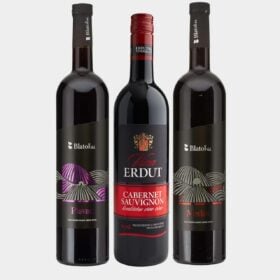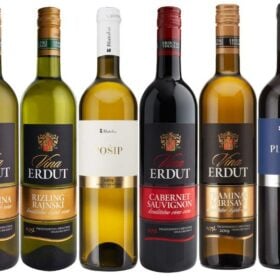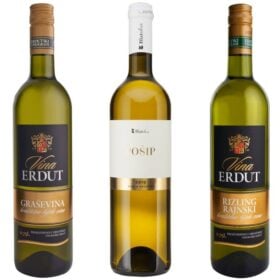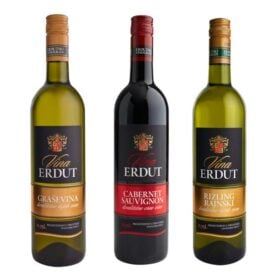Open a wine bottle and serve it with the flair of one sommelier requires some knowledge and technology. There's no need to be overly formal – after all, wine should be a pleasure – but there are some guidelines that can help you open and serve your wine bottles optimally. Before we get into how to open a wine bottle, it's important to remember that opening a wine bottle and drinking wine should never be rushed; the wine needs time to be appreciated, tasted and enjoyed until the last drop.
When you open a bottle of wine, remember to remove any foil or wire caps on the bottle neck first. These can be easily removed with a special foil cutter or simply by carefully cutting around the circumference of the top of the wine bottle with a knife. It is also advisable not to shake or shake the bottle of wine too much when you try to open it; this can release air bubbles that it aroma and affect the taste
After opening, pour no more than one glass at first to check for sediment in the wine bottle - if any, continue pouring slowly until all sediment has been removed from the wine. The ideal way to pour any glass is to hold it firmly at an angle and then turn it back vertically just as it is full; this prevents spilled drops and helps the temperature and the aroma to preserve. Red wines are usually served between 16°C – 21°C (ideally 18°C), while white wines best served at 7°C – 13°C (ideally 10°C)
Content
Use the correct tools when opening the wine bottle
When opening a still wine (wine type that does not contain carbon dioxide) the right tools are essential. It doesn't have to be pretty or decorated with labels; rather opt for something that is functional and made of durable material such as stainless steel or aluminum. To open effectively, unscrew the metal closure at the top of the bottle with a corkscrew or other special opener. Start by inserting the tip of the corkscrew into the cork, then slowly turn until about half an inch of metal is visible above the cork. Be careful not to pierce all the way through! Then use your hands or a pair of tongs to pull out the rest, being careful not to break any pieces to preserve the flavor optimally
If you want to ensure that your guests have an enjoyable experience with their wine, preparing and opening it properly is essential. By choosing a quality bottle and using the right tools, you can ensure that every sip tastes good. Developing the right uncorking techniques takes time and practice, but can help create lasting memories when friends and family gather around the table – ultimately an unforgettable experience for all involved.

Wine bottle with a screw cap
When opening a bottle of wine, the screw cap is gaining popularity due to its ease of use. To open a wine bottle with a screw cap, grip the wine bottle firmly and twist the cap off with an even wrist movement. It is important that the label remains clearly visible so that you can easily see what kind of wine you are drinking
On the other hand, if your wine bottle has a cork stopper, you'll need to use a corkscrew knife to cut the capsule away from under the rim before attempting to pry the cork out. Be careful not to push too hard with the corkscrew blade, as fragments of the cork may fall into your drink. Once you're close enough to it and ready to pull it off, it's important to take some precautions, such as snooping around for musty smells that could indicate air is getting through and oxidizing your wine. This usually happens if there is a defect in the cork itself
Whichever type of cork you use, it's always important to handle it with care and watch for signs that something isn't quite right. As long as everything looks good and passes the inspection when examined, you can get started! Enjoy responsibly!
Open a bottle of champagne or other sparkling wine
When opening a bottle of sparkling wine or Champagne there are a few methods that can be used. A popular way is to create an exciting atmosphere by making a "pop" and letting the cork shoot into the air. But while this can be fun, it can also be dangerous, as the flying cork can eventually cause damage or even injure people. It can also lead to spillage if the pressure causes some of the sparkling wine to overflow. A more controlled approach is to remove the capsule and cork first, then hold the cork with one hand and turn the wine bottle at a 45-degree angle with the other hand. This way you reduce the pressure and prevent excess bubbles from escaping when you open it.
When opening a bottle of wine, it is important for sommeliers and wine enthusiasts to understand the proper way to do so. Instead of twisting the cork itself, you just need to twist the bottle to open it. When you feel the cork come loose, press gently with your hand so it doesn't pop out or break. It is important that the cork comes loose at a slow pace so that when it comes out of the bottle there is only a soft "pop" rather than an audible pop. This is one of the most important elements of etiquette that will make opening the wine an enjoyable experience.
This process may take a little longer than simply popping the cork with a bang, but it has numerous advantages over this method. First, it's much safer for both people and property around you because you don't have to worry about anything getting damaged by a stray cork.
Plus, there's no risk of losing your precious sparkling wine – perfect for when you want to savor every drop! Plus it reduces wastage as it releases slowly so all your bubbles end up in the glasses and not on surfaces and clothing that no one wants covered in sticky liquid!

The right amount of oxygen during the decant
To improve the taste of a wine decant an essential step. In this process, the wine is transferred from the bottle into another vessel so that oxygen can mix with the liquid. By doing this, the tannins in certain types of wine are toned down and softened, and sulfuric odors may be present in it aroma could linger be eliminated. To accurately determine how long each type of wine should be oxygenated, several factors must be taken into account, such as grape variety, vintage year, temperature and general style. In general, wines with a higher tannin content will have to age longer decant than others, requiring no more than twenty to forty minutes
Red wines usually benefit the most from this process, as they have more intense flavors and aroma's than have other types. Decanting can help improve flavor while reducing astringency. although White wine and some rose wine don't need to be aerated for as long as Red wine, they should still be aerated to improve their complexity and bouquet. It is important to keep in mind that aging causes certain changes in a wine's profile, which must also be taken into account when determining an adequate aeration period. Especially for old wines, precision is essential: if they are kept in an open barrel for too long, they can become too delicate and fragile and lose much of their appeal.

Using a carafe
Finally, always have decanters ready for older wines; this helps to separate the sediment from the liquid and gives others aroma's time to develop in this type of wines. Allowing your guests to experience these scents will certainly make your dining table more refined! From opening your wine bottles with care to carefully assessing sediments, serving temperatures and decanting techniques; following these simple steps will ensure every sip is perfect!
If you want to make a good impression, it's important to choose the right bottle of wine and make sure it's been standing upright for at least 24 hours before you open it. This is essential for both young and old wines as it allows the sediment to settle at the bottom of the bottle. When thinking about what to say when serving the wine, try not to get too technical – just explain why you chose this particular wine and how it goes well with the meal.
When it comes to deciding where to store wine, etiquette would suggest having a separate decanter for each type of wine. However, this may not be practical for many households that lack storage space for multiple carafes of various shapes and sizes. That is why it is important to find a single carafe that is made of an inert material such as crystal, glass or porcelain and is aesthetically pleasing. In addition, it should ideally be easy to clean so that no odors remain.
The contact surface with the air is also an important factor when choosing a barrel for your wine. For younger wines, containers with a larger surface area are recommended, as they significantly accelerate oxidation. In contrast, mature wines are better suited to smaller casks as they slow down the process of oxygenation.
If space is limited, aerators can be used as an alternative solution – small instruments that mix oxygen into the wine faster than in a decanter.
Attention to detail when opening wine bottle
Serving wine perfectly requires great attention to detail. From bringing the wine bottle to the table unopened to serving the drink at the optimum temperature for its type, there are many steps that must be taken to ensure a successful experience
For sparkling wines, such as champagne or prosecco, it is recommended to serve them between 6-8 degrees Celsius. Aromatic whites and rosés must be refrigerated between 10-14 degrees, while red wines usually should be served slightly higher at 13-16 degrees Celsius. Lighter wines can also be enjoyed at cellar temperature, which is usually between 13-16 degrees Celsius. On the other hand, full-bodied wines and dessert wines may require slightly higher temperatures of 18-20 degrees Celsius.
Glühwein is undoubtedly an exception – it should be served piping hot, preferably outside with snowflakes falling all around!
When presenting the bottle of wine at the table, it should never be taken by the neck, but held by the bottom so as not to obscure the label or details. The pouring of the wine also follows a very specific protocol; one must stand to the right of the diner to perform this task
In short, when it comes to serving wine, etiquette requires more than just uncorking a wine bottle and pouring a few glasses – there is an almost ceremonial meaning to every step that must be respected if one is to have an unforgettable experience with one's want to drink!

The influence of wine glasses don't underestimate
When drinking wine, we often have to think carefully about the type of glass we use. Different wines require different glasses to taste and blend aroma to experience the drink optimally. This is because drinks with more complex aromas, like white wines, need a medium-width round cup to concentrate their flavors effectively. On the other hand, if you are looking for a glass for your sparkling wines, or simply for drinks whose bubbles linger longer, a flute with a long and narrow design is recommended
In terms of having enough glasses for all your friends when you're at home, it can be difficult to have a comprehensive set of individual glasses for each type of wine. That's why we recommend investing in one or two versatile glasses that can handle multiple types of drinks; after all, sharing among all your guests is what makes drinking wine so much fun! Furthermore, it is important not to mix different types of alcohol in the same glass as this can cause contamination between one drink and another
If you're looking for the most optimal way to enjoy your favorite wines and socialize with friends at the same time, investing in a pair of quality glasses can be an excellent solution. Not only will they help you enhance the tasting experience by making sure each drink is poured into its designated vessel; they'll also make sure there's no accidental contamination between drinks, while still providing enough cups for everyone involved!
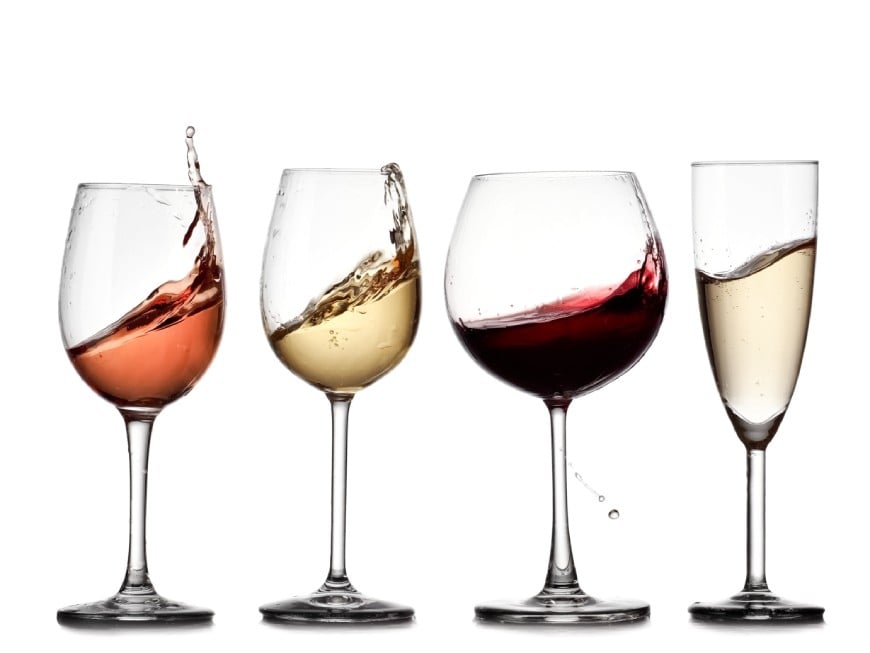
Keeping the correct order when opening a wine bottle
When drinking wines, the order is essential to get the full experience. To begin with, you should always start with the least intense and structured wines and gradually move to the more powerful ones. This is especially important if you're enjoying a meal at the same time - choosing the right wine is key to making sure it doesn't overwhelm or get lost amongst the others aroma's and flavors of it eten. If you know how to pair wines with different dishes, you can create a harmonious balance between the two elements
What happens if there's some wine left over when you're done? It is important to close the wine bottle tightly (especially if it is sparkling) with a special sparkling wine stopper or cap. You also need to make sure it is kept at an optimal temperature depending on the type; white wines should you keep in the fridge while red wines somewhere cool and dark until they can be drunk again. Of course, an exception applies to fortified wines, because they can be kept for up to a month after opening
If you want to cook something special with wine as an ingredient, why not try one of these delicious recipes? Stewed meat, Risotto's and reductions all provide fantastic opportunities to experiment with different types of alcoholic drinks without compromising on taste.
Croatian wine to experience
The taste of Croatian wine is an absolute delight that everyone should experience. Carefully crafted from a variety of locally sourced ingredients, Croatian wines are known for their unique flavor profiles and intriguing aromas. From powerful red wines to fresh white, there is a perfect bottle Croatian wine for every occasion. The country mostly produces dry red and white wines and semi-sweet dessert wines.
Croatian wines have been around since ancient times. It is believed that the Greeks first brought grape vines to the region during colonization in the fourth century BC. Since then, Croatia has been producing some of the world's best wines. The country has many famous appellations, such as Plavac Mali, Posip, Dingach en Babić, which are mainly found in the regions Dalmatia en Istria on the Adriatic coast and Graševina which is mainly made in the continental part of Croatia .
The best way to appreciate Croatian wines is to visit one of the many vineyards or wineries. Here you can see the production process from start to finish teaching methodology know and gain insight into the characteristic "terroir" that gives these special wines their distinctive character and taste. Winegrowers in Croatia use traditional methods passed down through generations to produce high quality grapes, which are then used to produce local wines such as Plavac Mali, Malvasia and Grk – all excellent examples of fine wine production in Croatia.
If you prefer something sparkling, head to Primošten for a memorable tasting experience: try Šampanjac or Prošek – two popular types of sparkling wine made with indigenous varieties such as Babić of Maraština grapes that grow in this region known for its unique microclimate ideal for the production of grapes of exceptional quality
Regardless of your wine preference, Croatia really does have something for everyone! Whether you are a fan of light white wines or deep red wines; whether you want something sweet or something dry; the Croatian winemakers master them all! With its beautiful scenery, great hospitality, rich culture and delicious cuisine – a visit to one of the fantastic Croatian wineries is simply an experience not to be missed!




